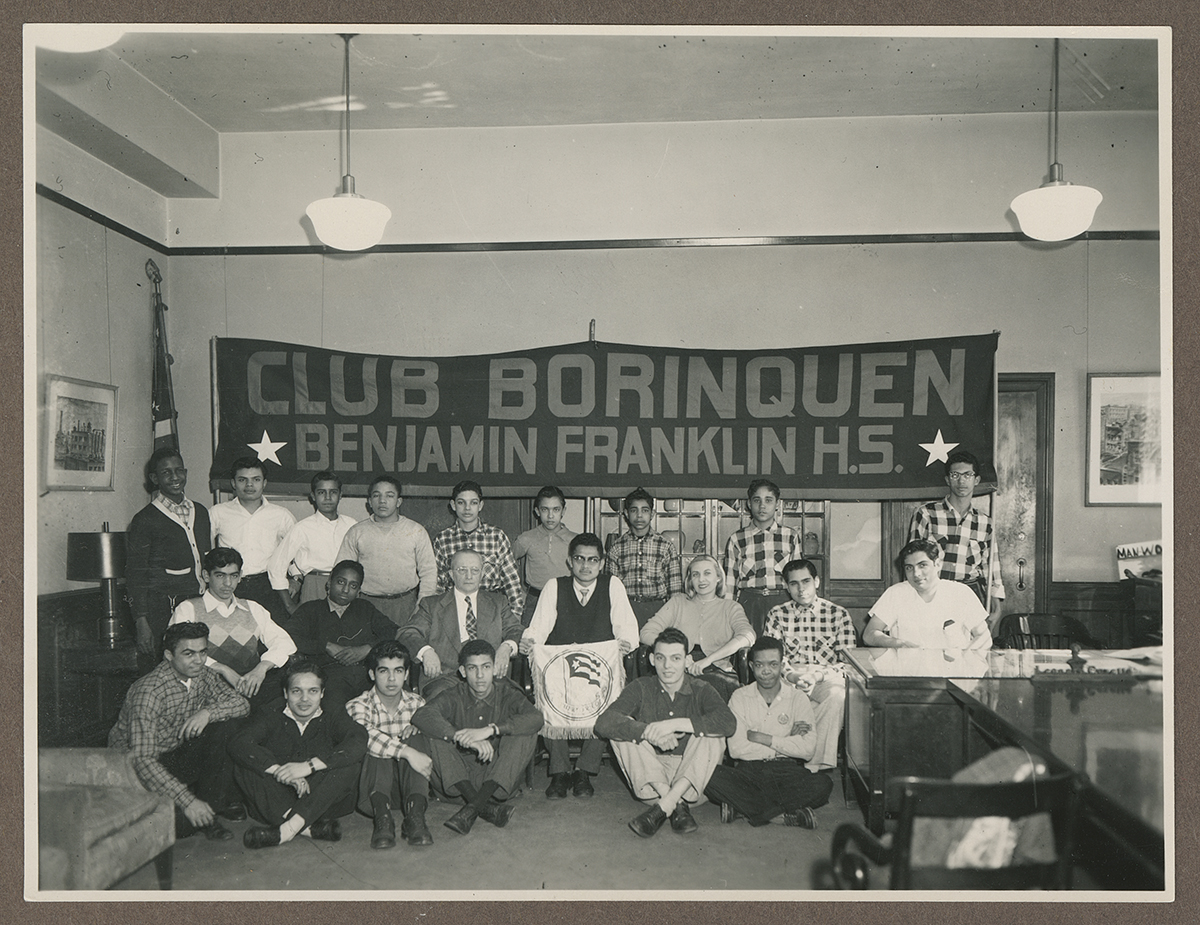Club Borinquen

Date: undated, c. 1940s-1950s
Caption: Students in Club Borinquen at East Harlem’s Benjamin Franklin High School. The club name references the Taíno name for the island of Puerto Rico.

Italian immigrant Leonard Covello was the principal of East Harlem’s Benjamin Franklin High School, an all-boys school. Drawing on his own experience immigrating to the US, Covello wanted to create a school where students’ home cultures could connect to the school’s. Early in the 20th century, most of Franklin’s students were Italian American. Covello created spaces within the school to welcome parents and community members, including through specific Italian American clubs, and extended the school out into the community. He opened a multilingual library and a job placement center on a street close to the school, and welcomed students and parents there.
In the 1930s and 1940s, Puerto Rican migration to the mainland United States increased, and many chose East Harlem as home. In keeping with the school’s earlier efforts to link home and school culture, the school sponsored Club Borinquen for its Puerto Rican students.1 Borinquen (or Borikén) was the historic Taíno name for the island of Puerto Rico. Some teachers used discussion of film clips in class to encourage students to be critical of racism around them.2
Although school leaders like Covello said that they wanted to create a community where everyone was welcome, there were tensions between student groups, sometimes provoked by events far from the school. In 1935, Italy, under the dictator Mussolini, invaded Ethiopia. News of invasion led to conflict between Black students and Italian American students in the school and in East Harlem.3
-
Michael C. Johanek and John Puckett, Leonard Covello and the Making of Benjamin Franklin High School: Education as If Citizenship Mattered (Philadelphia: Temple University Press, 2007). ↩︎
-
Lisa Rabin and Craig Kridel, “Cinema for Social Change: The Human Relations Film Series of the Harlem Committee of the Teachers Union, 1936–1950” in Educating Harlem: A Century of Schooling and Resistance in a Black Community, ed. Ansley T. Erickson and Ernest Morrell (New York: Columbia University Press, 2019), 103-118, https://ansleyerickson.github.io/book/chapters/04/. ↩︎
-
Johanek and Puckett, Leonard Covello and the Making of Benjamin Franklin High School. ↩︎
Categories: Manhattan, K-12 organizing, teacher activism
Tags: Harlem, bilingual education, Latinx people, Black people, joy, photography, imagery, and visual representation, Spanish language, immigrants and migrants
This item is part of "Benjamin Franklin High School" in "Joyful Struggle"
Item Details
Date: undated, c. 1940s-1950s
Source: Balch Historical Institute, Historical Society of Philadelphia
Copyright: Under copyright. Used with permission. Courtesy of the Balch Historical Institute, Historical Society of Philadelphia
How to cite: “Club Borinquen,” in New York City Civil Rights History Project, Accessed: [Month Day, Year], https://nyccivilrightshistory.org/gallery/club-borinquen.
Questions to Consider
- How do you think students felt about Club Borinquen? What can we tell from the photograph? What questions do you have about the club?
- Do you agree with Leonard Covello that students need spaces at school that link home and school culture? Why or why not? Are there spaces like that at your school? Are these joyful spaces?
- If you were going to create a space to experience joy with other peers and/or others who share your culture, what kind of space would it be? What would you imagine?
- How can schools work against racism? How can joy be part of that work?
References
How to Print this Page
- Press Ctrl + P or Cmd + P to open the print dialogue window.
- Under settings, choose "display headers and footers" if you want to print page numbers and the web address.
- Embedded PDF files will not print as part of the page. For best printing results, download the PDF and print from Adobe Reader or Preview.
